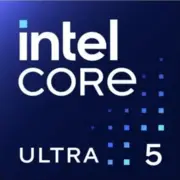Intel Core Ultra 5 125H

Intel Core Ultra 5 125H: The Perfect Balance for Mobility and Performance
March 2025
Modern laptops require processors that offer not just power, but also energy efficiency. The Intel Core Ultra 5 125H, built on the Meteor Lake architecture, provides just that balance. Let’s explore who this chip is suitable for, how it performs in real tasks, and what to consider when choosing a device.
Architecture and Process Technology: Hybrid Power and New Technologies
Hybrid Core Architecture
The Intel Core Ultra 5 125H is designed using hybrid technology, combining three types of cores:
- 6 Performance-cores (P-cores) with Hyper-Threading support (12 threads). Base frequency is 3.6 GHz, max in turbo mode is 4.5 GHz.
- 8 Efficient-cores (E-cores) without multithreading (8 threads). Operate at frequencies up to 3.4 GHz.
Overall: 14 cores and 18 threads. This configuration is optimized for multitasking: P-cores handle "heavy" applications, while E-cores reduce power consumption in background tasks.
7nm Process Technology and Foveros 3D Packaging
Meteor Lake is the first Intel processor to utilize Foveros 3D technology. This allows for stacking chips (computational modules, graphics, controllers) in layers, reducing delays and chip area. The 7nm process (Intel 4) provides a performance boost of 15-20% compared to the 10nm Alder Lake at the same TDP.
Integrated Intel Arc Graphics
The built-in GPU is Intel Arc Xe-LPG with 128 execution units (EU). It supports ray tracing, AV1 decoding, and achieves up to 60 FPS in games at 1080p on low settings (e.g., Fortnite, CS:2). This is sufficient for everyday graphic tasks (photo editing, 4K video).
Power Consumption and TDP: Efficiency without Compromise
The nominal TDP of the processor is 28W, making it part of the mid-power mobile chip segment. However, Intel Dynamic Tuning Technology 3.0 allows laptops to flexibly adjust TDP in the range of 20-35W depending on load and cooling system.
- In Power Saving mode (20W), the processor lowers frequencies to extend battery life.
- In Turbo Mode (35W), maximum performance is unleashed for rendering or gaming.
This flexibility makes the Core Ultra 5 125H a versatile solution for ultrabooks and compact workstations.
Performance: Real Tests and Turbo Mode
Office Tasks and Multitasking
- Geekbench 6: 2256 (Single-Core), 10239 (Multi-Core). For comparison: Ryzen 5 7640U scores ~2100/9800, Apple M3 — ~3100/11500.
- Running 30 tabs in Chrome + working in Excel + Zoom puts load on the E-cores, with consumption not exceeding 15W.
- Rendering a 10-minute video in DaVinci Resolve takes about 8 minutes (compared to ~10 minutes for Core i5-1240P).
Gaming and Multimedia
- The integrated graphics handle Cyberpunk 2077 on low settings (1080p, 25-30 FPS). For comfortable gaming, it’s better to connect an external GPU via Thunderbolt 4.
- 4K streaming on Netflix with hardware AV1 decoding puts the CPU load at less than 10%.
Turbo Mode: Pros and Cons
Under load (e.g., exporting a project in Premiere Pro), the CPU maintains 4.5 GHz for 15-20 seconds, then stabilizes at 3.9-4.1 GHz due to heat. In laptops with powerful cooling systems (such as the ASUS Zenbook Pro 14), throttling is minimal.
Usage Scenarios: Who is the Ultra 5 125H Suitable For?
1. Students and Office Workers — multitasking, long battery life.
2. Freelancers — video editing, working in Figma or Lightroom.
3. Travelers — compact ultrabooks weighing up to 1.5 kg.
4. Casual Gamers — games like Dota 2 or Genshin Impact without a discrete GPU.
Not recommended for: 3D modeling in Blender, 4K streaming, professional gaming.
Battery Life: How Long Will the Battery Last?
With a battery capacity of 60-70 Wh (standard for ultrabooks in 2025):
- Web and Office work: 9-11 hours.
- Video Playback: 7-8 hours.
- Heavy Load (rendering): 2-3 hours.
Power-saving technologies:
- Intel Thread Director — distributes tasks between P- and E-cores.
- Adaptive Brightness Control — syncs with light sensors.
- Deep Sleep S0ix — reduces power consumption in standby mode to 0.5W.
Comparison with Competitors
AMD Ryzen 5 7640U
- Pros: Better RDNA 3 graphics (8-12 FPS in games), USB4 support.
- Cons: Weaker in single-threaded tasks (by 10-15%), less software optimization.
Apple M3
- Pros: Battery life up to 18 hours, cool operation.
- Cons: Limited compatibility with Windows programs, no Thunderbolt 4.
Intel Core i5-1340P (Previous Generation)
- The Ultra 5 125H is 25% faster in multi-threaded tasks but consumes 5-7% more energy.
Pros and Cons of the Processor
Strengths:
- Ideal for hybrid work (office + multimedia).
- Support for Wi-Fi 7 and Thunderbolt 5.
- Low heat generation in daily scenarios.
Weaknesses:
- Integrated graphics are weaker than AMD RDNA 3.
- Throttling may occur under load in budget laptops.
Laptop Selection Recommendations
1. Type of Device:
- Ultrabooks (Acer Swift 5, Lenovo Yoga 9i) — weight up to 1.3 kg, 2.8K screens.
- Business Laptops (Dell XPS 14, HP EliteBook 840) — security, RJ-45 ports.
2. What to Look For:
- Cooling: 2 fans + heat pipes.
- Battery: At least 60 Wh.
- Screen: IPS or OLED with HDR400.
Average price for laptops with Core Ultra 5 125H: $900-$1300.
Conclusion
The Intel Core Ultra 5 125H is an optimal choice for those looking for a balance between mobility and performance. It is suitable for:
- Digital nomads valuing battery life.
- Freelance designers working in "the field".
- Users who want to run undemanding games without a discrete GPU.
Key advantages include flexible power management, support for modern communication standards, and a reasonable price. If you are not planning to render 8K videos or play AAA titles at ultra settings, the Ultra 5 125H will be a reliable companion for the next 3-4 years.
Basic
CPU Specifications
Memory Specifications
GPU Specifications
Benchmarks
Compared to Other CPU
Related CPU Comparisons
Share in social media
Or Link To Us
<a href="https://cputronic.com/en/cpu/intel-core-ultra-5-125h" target="_blank">Intel Core Ultra 5 125H</a>





